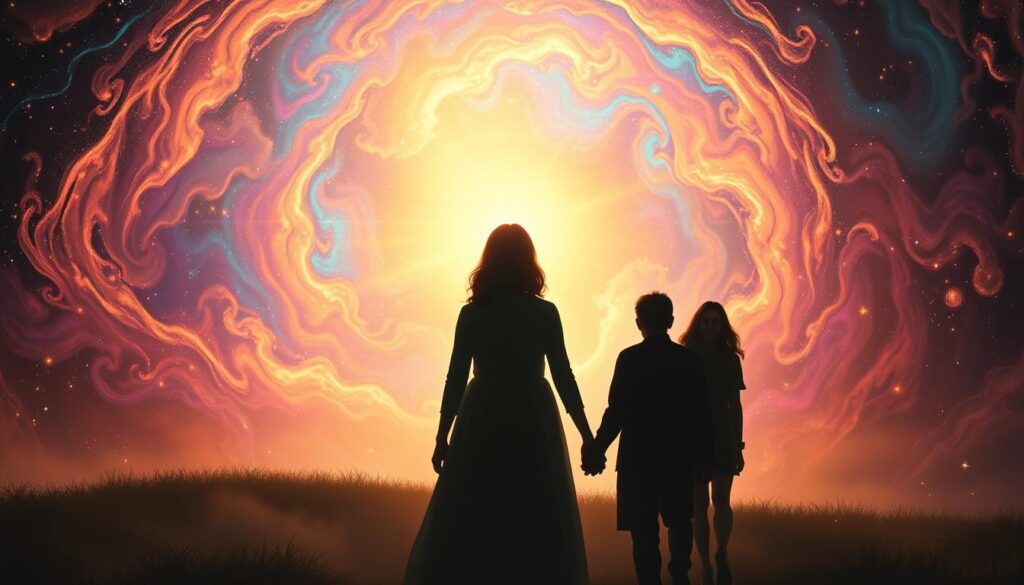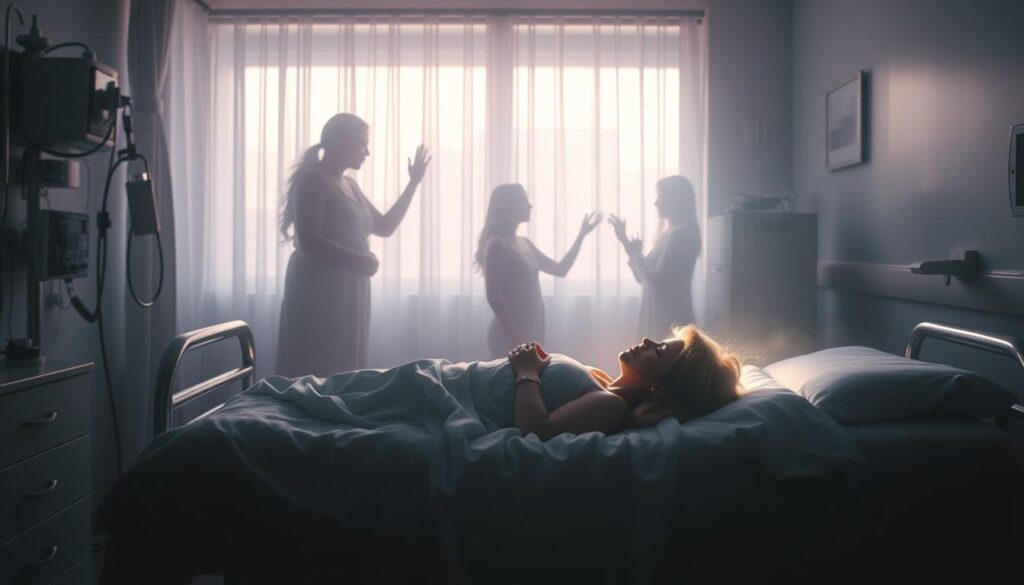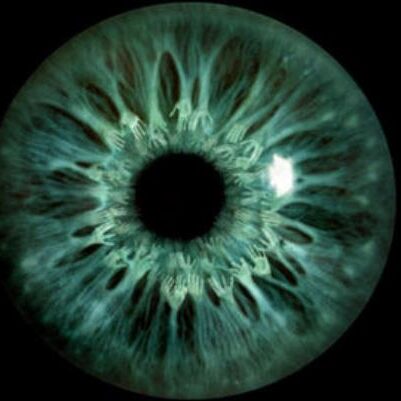Ever thought about what lies beyond our physical world? The idea of life after death has fascinated people for ages. From near-death experiences to reincarnation stories, researchers are finding clues that suggest our consciousness might not end with our bodies.
In this deep dive, we’ll look at the strongest evidence for life after death. You’ll hear about people who’ve had out-of-body experiences and deathbed visions. We’ll also dive into scientific studies that explore the nature of consciousness and if it can exist beyond our bodies.
Whether you’re curious, skeptical, or have had a paranormal experience, this article aims to give you a fair view. It’s a journey that might make you rethink what you believe about life after death. It could even open your mind to the idea that our consciousness might live on after our bodies do.
Key Takeaways
- Explore the most compelling evidence for life after death, from near-death experiences to scientific research.
- Discover the fascinating accounts of people who have reported out-of-body experiences, deathbed visions, and connections with the afterlife.
- Examine the scientific research that sheds light on the nature of consciousness and the possibility of an existence beyond our physical plane.
- Understand the perspectives of major religions on the afterlife and how they inform the ongoing search for answers.
- Gain a balanced and informative perspective on the mysteries of life after death, challenging preconceptions and opening your mind to the tantalizing possibility of consciousness beyond the physical form.
Near-Death Experiences: A Glimpse Into the Afterlife?
Near-death experiences (NDEs) have fascinated people for years. They give us a glimpse of what might happen after we die. People who have come close to death often share stories of being outside their bodies, meeting loved ones who have passed away, and traveling through tunnels of light.
Accounts of Near-Death Experiences
NDEs happen to people from all walks of life. It’s estimated that up to 18 million Americans have had one. Cardiac arrest is a common cause, affecting about 10% of survivors who remember their experience. Many also report out-of-body experiences (OBEs), which happen in 76% of NDE cases.
Common Themes and Patterns
- Tunnels of light or darkness, often symbolizing a transition to a transcendent realm beyond the physical world.
- Out-of-body experiences, where individuals feel detached from their physical bodies and perceive themselves from an external perspective.
- Encounters with angels, deceased loved ones, or beings of light, providing comfort, guidance, and a sense of interconnectedness.
- A life review, where individuals reflect on their past actions, leading to personal growth, forgiveness, and a deeper appreciation for existence.
- Feelings of peace, serenity, and love, transcending earthly worries and fears.
These common themes and patterns suggest that near-death experiences may offer profound insights into the nature of consciousness and the possibility of an afterlife. They spark ongoing discussions and research within the scientific and spiritual communities.
“Near-death experiences offer profound insights into spirituality and consciousness, leading to personal and spiritual growth, increased compassion, and a greater appreciation for life.”
The Science Behind Near-Death Experiences
Scientists have always been curious about near-death experiences (NDEs). They try to figure out what happens during these deep and often life-changing moments. Even though we don’t know all the answers yet, some ideas have been proposed to explain NDEs.
Neurological Explanations
One idea is that the brain gets very active when it’s about to shut down. This could lead to a heightened sense of awareness and vivid experiences. Research by Sabom, van Lommel, Parnia, Schwaninger, and Greyson has shown this in over a hundred NDE cases.
These experiences often involve seeing things that are far away, which can later be confirmed by others. This is seen in Cook, Greyson, and Stevenson’s research.
Studies also point to the brain’s thalamocortical connectivity being disrupted during unconsciousness. This is shown in White and Alkire’s work. It suggests that the unusual brain activity might be why we have NDEs.
Research by Aminoff, van Lommel, and Parnia found that people often forget what happened right before or after a cardiac arrest. This includes the time of their NDE.
Greyson, Kelly, and Kelly have also looked into NDEs in a cardiac care unit. Their findings, along with the fact that NDEs happen everywhere, have made scientists keep talking about consciousness and the brain.
As scientists keep studying NDEs, one thing is clear. These experiences can change how we see our minds, brains, and consciousness.
Most Compelling Evidence for Life After Death
Many believe in life after death, based on near-death experiences, reincarnation, out-of-body experiences, and communications with the dead through mediumship. These suggest that our consciousness might not end with our bodies. They hint at an afterlife.
A Gallup poll found that 82% of Americans believe in life after death. Near-death experiences are especially interesting. They often involve feeling out of the body, moving towards a bright light, and meeting loved ones who have passed away. These stories share common themes, showing a universal experience.
Neurologists have tried to mimic parts of near-death experiences, like feeling out of the body. They’ve probed the right temporal lobe of the brain. But they can’t fully recreate the deep, loving feelings found in these experiences. This hints that there’s more to near-death experiences than just brain activity.
Other evidence comes from reincarnation and out-of-body experiences. Researchers like Belo have looked into mediums talking to the dead and past life memories. These studies add to the case for life after death.
The reliability of mediums is debated, but the amount of research on these topics is vast. Jeffrey Long, who has studied over 5,000 near-death experiences, believes there’s no scientific explanation for them. He says, “There isn’t a scientifically plausible physical explanation for near-death experiences.”
“NDEs often lead individuals to embrace growth in love, wisdom, and knowledge as the main purposes of life.”
The evidence for life after death is intriguing and worth exploring further. As we delve deeper into these phenomena, we might learn more about consciousness and the human experience.

Out-of-Body Experiences: Leaving the Physical Form
Out-of-body experiences (OBEs) are fascinating and have caught the attention of many. People say their consciousness or “self” leaves their body and watches it from afar. These moments, often during near-death experiences, hint that our consciousness might not be tied to our bodies. This idea supports the notion of life after death.
Studies show that 10% to 20% of people who have had heart attacks report feeling out of their bodies. They see light and meet deceased relatives. About 1 in 10 people say they’ve had such experiences, and surveys suggest 800 million people worldwide might have had them too.
The study of near-death experiences has grown a lot in the last 30 years. In 1975, “Life After Life” by Raymond Moody shared stories of 150 people who had intense experiences during heart attacks. This book became a bestseller and sparked more interest in the topic.
There’s still debate on what causes OBEs and near-death experiences. Some believe they are real visits to the afterlife, while others think they are just reactions to death. Yet, these stories keep drawing in researchers and the public.
As near-death studies grow, we might learn more about consciousness and life after death. These experiences could lead to new discoveries and a deeper understanding of the world.
Reincarnation Stories: Past Life Memories
The idea of reincarnation has fascinated people for ages. It suggests that our consciousness moves to a new body after we die. While science hasn’t proven it, some stories are quite compelling. They involve young kids who remember their past lives vividly.
Cases of Children Recalling Past Lives
In the last 50 years, researchers have found over 2,500 cases of reincarnation worldwide. Most of these are outside the U.S. About 30% of these cases show birthmarks or defects that match the memories of their past lives.
James Leininger, a young boy, remembered being a World War II pilot named James Huston. Ryan Hammons, another child, recalled being a Hollywood extra and talent agent in a past life.
Dr. Ian Stevenson was a leading researcher on reincarnation. He documented over 3,000 cases of kids remembering past lives. He verified more than 1,500 of these stories. Physicist Doris Kuhlmann-Wilsdorf says his work shows reincarnation is likely.
Dr. Jim Tucker took over Stevenson’s work. He has studied cases like James Leininger’s. His research supports the idea that our consciousness can exist in different bodies.
| Researcher | Contribution |
|---|---|
| Dr. Ian Stevenson | Documented over 3,000 cases of children with past life memories, verifying over 1,500 of them |
| Dr. Jim Tucker | Continued Stevenson’s research, including the case of James Leininger |
| Dr. Brian Weiss | Regressed over 4,000 patients since 1980 using Past Life Regression therapy |
These stories and research suggest that reincarnation and the afterlife are worth more study. They help us understand human consciousness better.

Deathbed Visions and Final Farewells
Deathbed visions are fascinating and debated. They are when people near death see or talk to loved ones or spirits. These experiences are comforting and meaningful, showing that our consciousness might keep going after our bodies stop.
Many cultures and histories have stories of these visions. Family and healthcare workers often see them. People with terminal illnesses find comfort in these stories, showing their importance in end-of-life care.
People see these visions in different ways. Some believe they show an afterlife, while others think they are memories or mind tricks. Yet, stories like Mark Ferguson’s grandfather’s vision show their touching nature, bringing comfort to all involved.
| Study | Findings |
|---|---|
| Cross-cultural survey by Osis and Haraldsson | Over 70% of deathbed visions are reported as ‘take-away’ experiences |
| Study by Giovetti (1999) | 40% of deathbed visions collected were categorized as ‘take-away’ |
| Analysis by Hour and Lange (1997) | Concluded that the hallucinations were contextual and comforting, often involving dead relatives or spiritual figures |
| Study by Gurney, Myers & Podmore (1886) | Quoted cases where individuals saw or interacted with deceased persons shortly before being informed of their death, showing examples of pre-death communication |
Research on deathbed visions is growing. It helps us understand consciousness and the afterlife. As we learn more, we see how these experiences comfort and support people and their loved ones at the end of life.

“The accounts of end-of-life visions allude to a variety of interpretations among individuals, with some seeing them as evidence of an afterlife while others perceive them as vivid memories or products of the mind.”
Mediumship and Afterlife Communications
Mediumship is the claimed ability to talk to the dead. Scientists have studied it a lot. Some say mediums can share real facts about the deceased, which might mean consciousness survives death.
Scientific Studies on Mediumship
A 2004 study by Robertson and Roy had 10 mediums and 300 people. They used a secret method to pick the participants. Another study by Beischel and Schwartz in 2007 also showed promising results, with 13 out of 16 readings correct.
But not all studies agree. A 2005 study by O’Keeffe and Wiseman found no significant results. They said general statements were often given more credit.
Despite mixed results, research suggests many people have after-death communications (ADCs). A study by Ken Vincent found 20.1% of reports had strong evidence. This shows the need for more research into mediumship and survival of consciousness.

“ADCs can occur years after a death, even when a person is no longer actively grieving, which challenges the notion that such experiences are solely based on wishful thinking.”
Quantum Consciousness and the Nature of Reality
Some theories in quantum physics and consciousness studies say consciousness might not just be in our brains. They think it could be a basic part of the universe. This idea, called “quantum consciousness,” could help us understand life after death.
The debate on quantum consciousness and the nature of reality is ongoing. Some scientists believe consciousness isn’t just from our brains. They say it’s a key part of the universe. This view challenges old ideas about space and time, saying they change based on who’s looking.
Those who support quantum consciousness think our brains might not make our minds. They believe there’s more to reality than we know. The biocentrism theory backs this up, saying without consciousness, space and time mean nothing. It also suggests death could be like a reboot, opening up new possibilities.
“Death is not the opposite of life, but a part of it.”
The argument over quantum consciousness and reality’s nature keeps going. Some doubt our minds are more than brain activity. But others believe in a deeper level of consciousness. As research grows, our views on consciousness and the afterlife could change a lot.
| Key Findings | Implications |
|---|---|
| Consciousness may not be solely dependent on the physical brain | Provides a scientific framework for understanding the possibility of life after death |
| Space and time are relative to the observer, not absolute constructs | Challenges traditional Newtonian views of the universe |
| The brain may not directly produce the mind or consciousness | Suggests the existence of another layer of reality yet to be discovered |
Religious Beliefs and the Afterlife
Many major religions, like Christianity, Islam, Hinduism, and Buddhism, focus on the afterlife. They explore what happens to our consciousness after we die. Each religion has its own views on the soul, heaven, and how we might continue to exist beyond our bodies.
Perspectives from Major Religions
In Christianity, the afterlife is tied to Jesus Christ’s resurrection and the promise of eternal life. Muslims believe in a Day of Judgment, where souls are judged and the righteous go to paradise. Hinduism and Buddhism believe in reincarnation, where the soul is reborn into a new body.
Though their teachings differ, these religions all believe in something beyond our physical lives. This belief gives many people a sense of purpose and hope, even in the face of death.
Belief in an afterlife is almost universal, with nearly every culture believing in it. Non-Western countries tend to believe more in life after death than Western ones. About 75% of Americans believe in an afterlife.
Even those without a specific religion find the idea of life after death intriguing. Scientific discoveries, like in quantum physics, might support the idea of realms beyond our world.
Paranormal Phenomena and the Survival of Consciousness
The debate about an afterlife is fueled by paranormal reports. These include ghost sightings, poltergeist activity, and memories of past lives. These unexplained events have captured the public’s interest and sparked discussions about consciousness after death.
Many people believe in an afterlife based on these reports. According to the provided material, many claim to have had supernatural encounters.
Near-death experiences (NDEs) are a strong evidence for consciousness survival. People who almost died often see loved ones and a bright light. These experiences deeply impact them, reducing their fear of death and increasing their understanding of the afterlife.
The scientific community is divided on these experiences. Yet, the many reports and their impact suggest there’s more to life than science can measure. The debate on consciousness survival and an afterlife continues.
“The argument from the authority of wise people and prophets does not provide proof for life after death, as it reveals preexisting beliefs.”
Interpreting Paranormal Experiences
Interpreting paranormal phenomena is complex and divisive. Some see these experiences as proof of an afterlife. Others believe they are hallucinations or coincidences. The question of consciousness survival remains unanswered, sparking ongoing debate.
- The evidence for paranormal phenomena, such as out-of-body experiences, near-death experiences, ghost sightings, mediums communicating with the dead, and memories of past lives, is not strong.
- Anecdotal reports are notoriously unreliable in paranormal occurrences, and reliable scientific methods tend to make these phenomena vanish.
- The argument from authority based on the majority of people believing in survival does not guarantee the validity of the belief.
| Paranormal Phenomenon | Potential Evidence for Survival of Consciousness |
|---|---|
| Near-Death Experiences (NDEs) | Accounts of encountering deceased loved ones, experiencing a bright light, and gaining a newfound appreciation for life |
| Out-of-Body Experiences | Reports of individuals perceiving their surroundings from a detached, disembodied perspective |
| Reincarnation Stories | Cases of children recalling past life memories, suggesting the possibility of consciousness surviving physical death |
Scientific Research on the Dying Brain
Recent scientific research has shed light on the brain’s activity when we die. Studies show that the brain might be more active and consciousness could change right before death. A case study of “Patient One” offers clues that consciousness might stay even as the brain stops working.
Patient One: A Groundbreaking Case Study
The study focused on an 87-year-old woman with epilepsy and seizures. It recorded 900 seconds of brain activity right before and after her heart stopped. This was a crucial time to study.
Researchers noticed changes in brain waves, like gamma oscillations. These patterns are linked to thinking, dreaming, and memory. They play a big role in how we perceive the world.
The study found that these brain wave patterns were similar to those seen in dreaming and meditation. This suggests that the brain might have a special response at death. This response could be shared among different species.
The study challenges the idea that the mind and consciousness come from brain activity. It suggests that consciousness might be something more, not just a product of the brain. This case study is a big step in understanding if consciousness can exist after the heart stops.
“The study provides insight into the brain’s activity during and even after the transition to death.”
Conclusion
The mysteries of life after death are truly captivating. We’ve seen how people who have come close to death have had clear experiences. These include cases of reincarnation and mediumship, showing that our existence might not be limited to our bodies.
Studies on the dying brain have found activity even when people are clinically dead. This challenges the idea that our consciousness stops when we die. It makes us wonder if our sense of self can go beyond our physical bodies.
Though we may never fully understand life after death, the evidence is compelling. It encourages us to keep exploring this topic. As you think about what we’ve discussed, you might feel a sense of awe and curiosity. The research also suggests that how we live now could affect our future experiences. This gives us both hope and a sense of responsibility.
FAQ
What are near-death experiences, and how do they suggest the possibility of life after death?
Near-death experiences (NDEs) happen when someone is clinically dead or very close to death. People often report leaving their body, traveling through a tunnel, and meeting deceased loved ones. They also talk about a being of light. These common themes in NDEs might show us glimpses of the afterlife.
What are the neurological explanations proposed for near-death experiences?
Scientists try to understand NDEs by looking at brain activity. They think a surge in brain activity might cause these vivid experiences. But, the exact reasons behind NDEs are still being studied and debated.
What other types of experiences and phenomena suggest the possibility of life after death?
Besides NDEs, there are out-of-body experiences, reincarnation stories, deathbed visions, and communications with the dead. These experiences suggest that consciousness might keep going after we die. They offer strong evidence for an afterlife.
What are out-of-body experiences, and how do they relate to the survival of consciousness?
Out-of-body experiences (OBEs) are when people feel their consciousness leaves their body. They can see themselves from another place. OBEs, especially during near-death events, show that consciousness might not need a body to exist. This supports the idea of life after death.
What are some examples of reincarnation stories, and how do they support the idea of consciousness continuing after death?
Some people, especially young kids, remember past lives. They recall details about their previous families and experiences. These stories of spontaneous past life recall suggest that consciousness can move from one body to another. They support the idea of reincarnation and an afterlife.
What are deathbed visions, and how do they relate to the survival of consciousness?
Deathbed visions are when people on their deathbed see or talk to loved ones who have passed away. These visions are often comforting and meaningful. They suggest that consciousness can stay active and interact with the spiritual world even as the body dies. This provides evidence for life after death.
What is mediumship, and how has it been studied in relation to the survival of consciousness?
Mediumship is when someone claims to communicate with the dead. Scientists have studied it to see if it’s real. Some research suggests mediums might share accurate information about the deceased. But, the science behind mediumship is still debated.
How do quantum consciousness theories relate to the possibility of life after death?
Quantum physics and consciousness studies suggest consciousness might not rely on the brain. Quantum consciousness theories propose that consciousness could exist independently. This idea offers a scientific perspective on life after death.
How do the world’s major religions view the afterlife and the survival of consciousness?
Many religions, like Christianity, Islam, Hinduism, and Buddhism, believe in an afterlife. They have different views on the soul, heaven, and how consciousness survives after death. These beliefs are central to their teachings.
What are some examples of paranormal phenomena that have been interpreted as evidence for the survival of consciousness?
Paranormal events, such as ghost sightings and poltergeist activity, are seen by some as proof of life after death. While their scientific validity is disputed, these experiences continue to spark interest and debate about the afterlife.
What have recent scientific studies revealed about the brain’s activity during the dying process?
New research shows the brain’s activity near death is more complex than thought. Studies, like the case of “Patient One,” suggest consciousness might persist even as the brain shuts down. This offers insights into the possibility of life after death.
Source Links
- Following My Dad’s Death, This Research Convinced Me Of An Afterlife – https://www.mindbodygreen.com/articles/research-on-the-afterlife
- What Evidence Is There of an Afterlife? Proof of Life Beyond Death – https://www.seekreality.com/exploring-what-evidence-is-there-of-an-afterlife-with-seek-reality
- The Case for Heaven: Evidence for the Afterlife – https://www.zondervan.com/p/the-case-for-heaven/
- Near-Death Experiences: Neuroscience Perspectives on Near-Death Experiences – https://www.ncbi.nlm.nih.gov/pmc/articles/PMC6170042/
- Understanding Near Death Experiences – NewChurch Live – https://newchurchlive.tv/understanding-near-death-experiences/
- Life After Life – https://www.lifeafterlife.com/
- Near-Death Experiences Evidence for Their Reality – https://www.ncbi.nlm.nih.gov/pmc/articles/PMC6172100/
- What Near-Death Experiences Reveal about the Brain – https://www.scientificamerican.com/article/what-near-death-experiences-reveal-about-the-brain/
- The Near Death Experience as Evidence for Life After Death | Issue 59 – https://philosophynow.org/issues/59/The_Near_Death_Experience_as_Evidence_for_Life_After_Death
- PDF – https://www3.nd.edu/~jspeaks/courses/2006-7/20208/empirical-afterlife.pdf
- I’ve studied more than 5,000 near death experiences. My research has convinced me without a doubt that there’s life after death. – https://www.businessinsider.com/near-death-experiences-research-doctor-life-after-death-afterlife-2023-8
- The new science of death: ‘There’s something happening in the brain that makes no sense’ – https://www.theguardian.com/society/2024/apr/02/new-science-of-death-brain-activity-consciousness-near-death-experience
- Explanation of near-death experiences: a systematic analysis of case reports and qualitative research – https://www.ncbi.nlm.nih.gov/pmc/articles/PMC10158795/
- Children Who Report Memories of Past Lives – Division of Perceptual Studies – https://med.virginia.edu/perceptual-studies/our-research/children-who-report-memories-of-previous-lives/
- Proof of Reincarnation: The Mind-Blowing Evidence of Past Lives! – https://www.thesouljam.com/post/is-this-undeniable-evidence-for-reincarnation
- My Sister Remembers Her Past Life. Somehow, I Believe Her. (Published 2021) – https://www.nytimes.com/2021/07/30/well/family/sisters-past-life.html
- Readers Share Stories of Their Loved Ones’ Deathbed Visions – https://www.nytimes.com/2024/04/10/magazine/readers-share-stories-of-their-loved-ones-deathbed-visions.html
- Microsoft Word – Edited Peter Fenwick – https://www.rcpsych.ac.uk/docs/default-source/members/sigs/spirituality-spsig/spirituality-special-interest-group-publications-pfenwickneardeath.pdf?sfvrsn=686898bc_2
- End-of-life experiences in the dying process: scoping and mixed-methods systematic review – https://www.ncbi.nlm.nih.gov/pmc/articles/PMC10850829/
- PDF – https://med.virginia.edu/perceptual-studies/wp-content/uploads/sites/360/2015/11/KEL13JNMD-2011-Mediumship-Paper.pdf
- My Patients Tell Me They’ve Had A Paranormal Experience. I Believe Them — I Had One Too. – https://www.huffpost.com/entry/hospice-patient-after-death-communications_n_66119c1ce4b0c063ffb957ee
- Compelling Evidence for Afterlife Messages Backed by Scientific Research: A Groundbreaking Exploration – The Eden Magazine – https://theedenmagazine.com/afterlife-messages/
- Near-Death Experiences, The Mind-Body Debate & the Nature of Reality – https://www.ncbi.nlm.nih.gov/pmc/articles/PMC6170087/
- What Science REALLY Says About the Soul (& Life After Death) – https://strangenotions.com/what-science-really-says-about-the-soul-life-after-death/
- What Happens When You Die? – https://beyondbiocentrism.com/biocentrism-why-you-wont-die/
- Evidence for Life After Death – Biola University Center for Christian Thought / The Table – https://cct.biola.edu/evidence-for-life-after-death/
- Life after death: What does the evidence show? – https://www.csmonitor.com/Commentary/Opinion/2009/1209/p09s02-coop.html
- Life After Death | Issue 39 – https://philosophynow.org/issues/39/Life_After_Death
- The Near Death Experience – https://www.csueastbay.edu/philosophy/reflections/2011-2012/contents/erik-edgr.html
- What Can Science Tell Us About Death? – https://www.nyas.org/ideas-insights/blog/what-can-science-tell-us-about-death/
- A replay of life: What happens in our brain when we die? – https://www.frontiersin.org/news/2022/02/22/what-happens-in-our-brain-when-we-die/
- Does a New Scientific Study Offer Evidence of Life after Death? – https://www.nationalreview.com/corner/does-a-new-scientific-study-offer-evidence-of-life-after-death/
- What Happens After Death? – https://www.psychologytoday.com/us/blog/understanding-hypnosis/202212/what-happens-after-death

